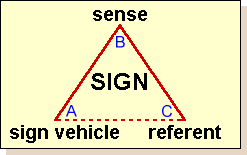related in that they all answer questions about communication and the cultural sphere. Here is the rough draft of a brief description and comparison of these modes of analysis.
THE MEDIA TRIANGLE

The media triangle is a basic tool for media analysis. Media text, audience, and production help answer basic questions about media (who?, what?, why?, etc.). This form of analysis is important because it requires a critical analysis of the producer, encouraging us to inquire about their methods and motivation of production. When considering media in a broader context of power dynamics, this sort of analysis is essential. In our hyper-commercial environments, questioning the intentions of the producer can upset the usually transparent flow of information from, say, advertiser to consumer. Considering the form of the advertisement itself can also elucidate the meanings of a media text.
Media, in the broadest sense, might include language. But in a more traditional sense, media records the thoughts, sounds, and images evoked by language. Thus, this traditional definition of media involves an extra layer of intention beyond spoken word, beyond simple utterances. Media also encompasses the will to record and preserve a particular thought or message in a particular way. This is intention is not necessarily present in the following two modes of analysis represented below.
PEIRCE'S SEMIOTIC TRIANGLE*

- Sign vehicle: the form of the sign;
- Sense: the sense made of the sign;
- Referent: what the sign 'stands for'.
Those concerned with power dynamics will want to question who controls this process of interpretation? Who controls the sense made of particular signs? Who has the upper hand in a given discourse about a given sign? For example, in the case of a printed advertisement, the ad itself is the sign vehicle. The referent is the product or service which it is advertising. And the sense made of the sign is the meaning perceived by those who encounter it. In most cases, the advertiser has the upper hand in this discourse, aiming to create a fairly uniform interpretation of the sign that results in consumption of the advertised product or larger profit.
*paraphrased from Semiotics for Beginners by Daniel Chandler
BERGER'S MODEL OF DIALECTIC WORLD CONSTRUCTION

Sociologist Peter Berger advances this model in The Sacred Canopy: A Sociogical Theory of Religion. The process described here is either "world contruction" or "self construction." Arguably it can be applied to individuals or a culture/community as a whole. The stages of this process are externalization, objectivation, and internalization. This process forms a loop.
When applied to the cultural sphere, this model can provide a similar analysis as the two above. Related to the media triangle, there is a direct parallel between externalization/production, objectivation/media text, and internalization/audience. Thus, in the example of advertising, a company may externalize information about a product, which is objectivated in the form of a print, broadcast or digital advertisement, which is then internalized by consumers. Naturally, both the example and model can readily be complicated. In comparison to the semiotic trianlge, there is a correspondence between objectivation/sign vehicle, externalization/referent, and internalization/sense.
Concrete examples would readily illustrate the relationships outlined above. Social scientific theory can become meaningless if it loses grounding in the real world. I'm interested in the application of these theories in relation to advertising and PR, but they can be applied to a much wider variety of media such as music, language, fashion, or visual art, to name a few.
Self, other, and the medium which connects them form a unifying theme between these models. The medium of connection between self and other is what forms media, signs, society, as well as communication and culture. Thus, there is an implicit connection between the modes of analysis used in media studies, semiotics, sociology, communications and anthropology.
ReplyDeleteIn my studies, I hope to focus on a holistic approach which draws elements from each of these related, social-scientific fields.